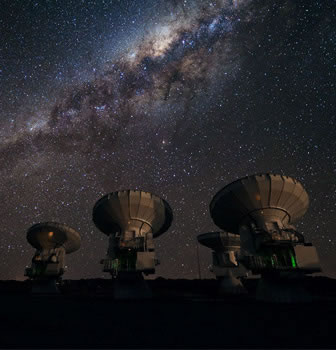Astronomers at the U. Chile participate to conferences in Asia
Wednesday, December 10, 2014

Promoting the scientific collaboration between nations and presenting the outstanding results obtained by ALMA telescope, such were the objectives of two different meetings held in China and Japon respectively, where several academics and researchers of the Department of Astronomy (DAS) of the Faculty of Physical Sciences and Mathematics of the University of Chile attended.
The so-called "Revolution in Astronomy with ALMA" meeting, organized in Japan at the Tokyo International Forum between December 8 and 11, enabled astronomers for all over the world to present their results obtained with ALMA telescope (Atacama Large Millimeter/submillimeter Array) during its first three years of science operations, and to promote collaboration with other participating researchers.
This initiative involved more than 290 scientists, among whom two academics of the Department of Astronomy (DAS) of the Faculty of Physical and Mathematical Sciences at the University of Chile: Diego Mardones who presented a poster on the SOLA collaborative projects, studying the region of star formation Lupus, and ChiVO, the Chilean virtual observatory; and Professor Monica Rubio who participated as a representative of our country in a panel discussion with the Director of ALMA, Pierre Cox.
Also attending this conference, the DAS researchers Andrés Guzmán with his research "Collimated ionized wind and rotating disk-like system associated with G345.4938+01.4677"; Gerrit Van Der Plas with his talk on "Detection and characterization of protoplanetary disks across the stellar/substellar transition"; and students of our Graduate Program Carlos Hervias with his talk on "ALMA observations of the massive molecular outflow G331.512-0.103:physical properties, kinematics and geometry modeling”, and Valentin Christiaens with his study of "Spiral arms in the transition disk of HD 142527".
Astronomy in China
In parallel, between December 7 and 10, the 4th Chile-China Science Astronomy Workshop took place in the city of Guangzhou to promote communication and cooperation between the two countries.
The event, organized by the China-Chile Joint Center for Astronomy (CCJCA), with the participation of scholars from DAS Ricardo Muñoz with his talks on "The Chilean Time Allocation Committee" and "A MegaCam survey of the Milky Way halo satellites"; Guido Garay with his presentations on "Astronomy at Universidad de Chile" and " High mass star formation"; Andrés Escala with "Numerical Astrophysics @ Universidad de Chile" and Patricio Rojo with "Ground-based detection of exoatmospheric Calcium".
The Chinese Academy of Sciences South America Center for Astronomy (CASSACA), or the China-Chile Joint Center for Astronomy (CCJCA), are overseas projects initiated by the Chinese Academy of Sciences to develop cooperation in science and technology with other countries. The center serves as a platform for collaboration in astronomical research and related technology with South American countries. The center will establish international scientific research teams and joint research programs engaging in astronomical science and technology frontiers.




